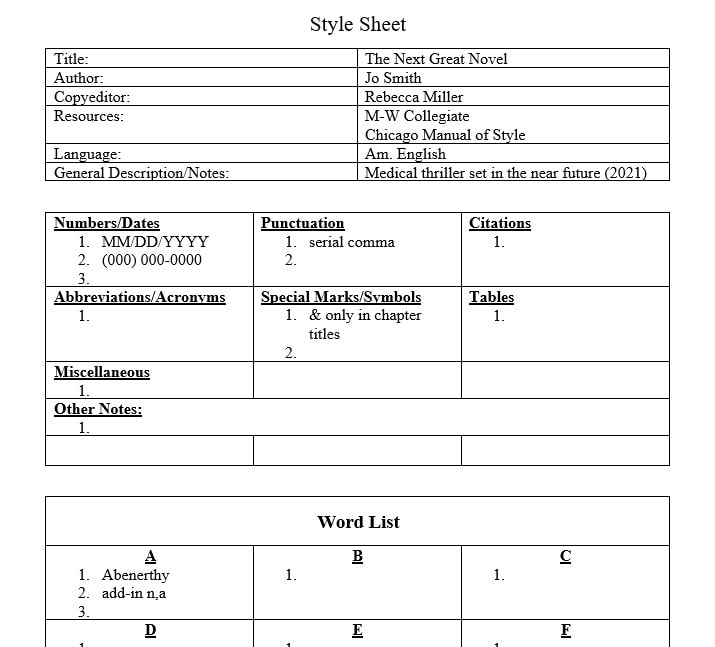|
Sara has decided to self-publish. She’s written, rewritten, and revised her novel, and all her family and friends rave about how amazing it is. She had several of them check it over, but she wants to get it right, so she sends it off to a carefully selected professional editor, Jack. Jack and Sara have agreed to follow Chicago style, so he gets to work on the editing process. He fixes all of the spelling and punctuation issues. He makes sure the main character’s best friend’s name doesn’t suddenly change from John to Jim in chapter seven. After weeks of hard work, he sends the manuscript back to Sara, who is horrified by the changes to her baby. Why are all of the numbers written out instead of numerals? It just looks wrong! And the Oxford comma? Just no. She wants it just right, so she sends it back to Jack who is happy to follow her preferences. And it’s not a big deal because a second round of editing was included in his quoted fee. Finally, everything is just the way Sara wants it, but she wants to be absolutely sure everything is perfect, so after getting her novel back from the designer/typesetter, she sends it off to a proofreader. But when it comes back, she’s once again horrified. All of the numerals are written out again, and that infernal Oxford comma has snuck back in! What happened? How could it have possibly gone so wrong? The problem lay in a lack of communication among all of the people working on Sara’s novel. She had definite opinions about stylistic choices, but because she didn’t communicate them to her editor or proofreader, they proceeded with the instructions they had: to follow Chicago style. The whole mess could have been avoided by creating a document, a simple set of instructions and preferences, and sending it along to each person working on the project. I’m talking about a style sheet. Most professional editors create a style sheet for each project they work on, if only for their own reference, but they may or may not pass it along. And if you, as the author, have stylistic preferences (as opposed to actual grammar rules), it’s a huge help to your editor to have those preferences laid out before they start their work. Chances are, though, you’ve probably never worked with a style sheet, if you even knew what one was before today. Don’t worry. It doesn’t have to be scary or confusing, and how intricate and complicated it gets depends entirely on the intricacy and complication of your document. I’ll even include a template of the basic style sheet I use. It’s essentially Word document with a series of tables with cells dedicated to different elements of your manuscript. What’s the purpose? The basic purpose of any style sheet is to ensure consistency, within the document itself or among the various people who work on it. And if you’re writing several books in a series, it’s especially helpful for keeping everything straight. As I said above, many editors will create a style sheet, but if you have certain preferences for spelling or punctuation or any other style or world-building choice, a style sheet is a great way to lay it out for your editor before they waste precious time. Once you’ve started the style sheet, your editor will probably add to it as they make additional style choices, and that document gets passed on to the proofreader so that they can distinguish what was a deliberate choice and what was missed by the editor or incorrectly entered by the typesetter and needs to be corrected. What goes on my style sheet? What you include on your style sheet depends entirely on your preferences and the genre you’re working in, but here are a few general categories. General Info about the ProjectThe first section of my style sheet starts with the name of the document and the author just to keep things organized. I also include the name of the editor, what resources I’m using (preferred style guide, dictionary, etc.), language, and a general description of the project. Style Preferences by Category The next section contains cells for different categories of style choices. For example, there’s a space for how to style numbers and another for capitalization preferences. Do you want phone numbers written 000-000-000 or (000) 000-000? Do you want to keep or drop the hyphen in certain words when they appear in titles and headings? If you’re working on an academic or scientific project, your manuscript might contain several tables, and listing out how you want them styled will help ensure that they’re all consistent. Word List This section is what it sounds like: a list A-Z of words from your document. Some of them may be listed out because you prefer a spelling or hyphenation that differs from the style guide or dictionary. Or they might simply be there because they’re words that proved problematic for the editor, and it saves time to add them to the word list rather than repeatedly looking them up. Also, some words are open, closed, or hyphenated, depending on whether they’re a noun, and adjective, or a verb. Sometimes, it’s best to lay it out and avoid confusion. There are also many specialized or technical terms that may not appear in the dictionary. Think of the word list as a dictionary tailored specifically for your manuscript. Character List Here, you might create a list of characters, with the chosen spelling and some basic facts about them, their background, and their relationships with other characters. It gives both you and your editor a reference to keep all of your facts straight as the story goes along. How embarrassing would it be to get all the way to print without realizing that one of your characters was someone’s uncle at one point and their brother at another? It also helps you make deliberate choices regarding character names. It’s not really a good idea to have three characters named Lisa, Liza, and Lizzy. While easy to do by accident and a common occurrence in real life, that kind of thing could easily confuse your readers. Other Data Specific to Your Project This section is especially important in sci-fi and fantasy, but it can also come in really useful in general fiction and even nonfiction. If the world you create contains magic or magical creatures, what are the rules and attributes specific to them? Even if you’re inventing that world purely from your imagination, in order for your readers to make sense of and connect with it, there need to be some rules, even if, again, you invented them out of whole cloth. What is the layout of your setting? Is Main Street parallel or perpendicular to the coast? A lot of this information won’t be included in the actual manuscript. It would make it incredibly boring to read. But for everyone working on constructing the story, having everything laid out clearly could be the difference between professional-grade storytelling and an amateur effort with potential.
Your style sheet doesn’t have to look like mine (or anyone else’s for that matter), but whatever it looks like, it’s an excellent tool and essential for producing a professional-quality finished document that’s ready for publishing success. If you'd like to download a free copy of the basic style-sheet template I use, click here. Rebecca Miller is a professional copyeditor and general fan of all things having to do with the written word and the English language. You can check out her website at Oakdale Editing or connect through Facebook, LinkedIn, or Email.
0 Comments
Leave a Reply. |
AuthorRebecca has a passion for helping you fill the world with great literature and making sure said literature doesn't get passed over for the lack of a little editing. Archives
July 2022
Categories
All
|


 RSS Feed
RSS Feed
